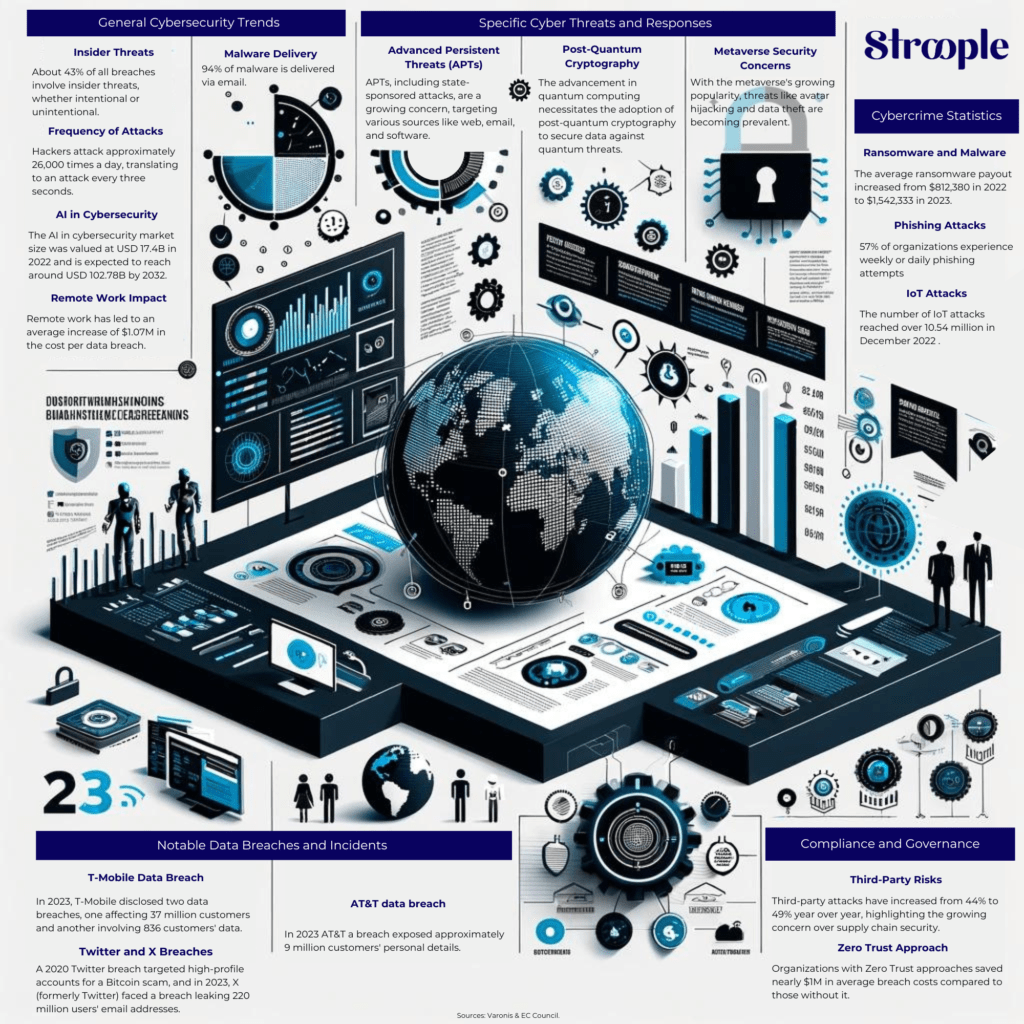Current Trends in Cybersecurity – An Overview of 2023
At the dawn of 2024, the world of cybersecurity is facing unprecedented challenges, marked by the increasing sophistication of threats and rapid technological changes. As the digital landscape continues to expand, emerging vulnerabilities and novel methods of attack are reshaping our approach to data security.

🔍 In this complex universe, where each click can hide a danger, understanding the current trends is more than a necessity. Here are the highlights of the evolution of cybersecurity threats for 2023, from internal threats to AI innovations, each aspect underscoring the imperative of constant vigilance and adaptation.
🔍 General Cybersecurity Trends
Internal Threats: Nearly 43% of breaches involve internal threats, intentional or not.
Malware Delivery: 94% of malware is transmitted via email.
Frequency of Attacks: Hackers launch approximately 26,000 attacks per day.
Impact of Teleworking: Teleworking increases the average cost per data breach by $1.07M.
AI in Cybersecurity: The AI in cybersecurity market, valued at $17.4 billion in 2022, is expected to reach about $102.78 billion by 2032.
Advanced Persistent Threats (APT): APTs, including state-sponsored attacks, target the web, email, and software.
Metaverse Security: With the growing popularity of the metaverse, threats such as avatar hijacking and data theft are emerging.
Post-Quantum Cryptography: Advances in quantum computing necessitate the adoption of post-quantum cryptography.
Sources: EC-Council & Varonis, 2023
🚨 Data Breaches and Notable Incidents
Lately, we are witnessing an alarming increase in large-scale and highly publicized data breaches. It’s not just the frequency of these incidents that is intensifying – their severity is also increasing. These breaches often lead to the exposure of sensitive information, putting individuals at an increased risk of identity theft. Beyond the personal impact, these incidents can severely damage a company’s reputation and lead to significant compliance liabilities. To better understand the scale and drivers of these concerning trends, here are some statistics on data breaches.
Data Breach at T-Mobile: In 2023, T-Mobile revealed two data breaches.
Data Breach at AT&T: In 2023, a breach in the AT&T system exposed personal data of about 9 million customers.
Data Breaches at Twitter and X: A breach at Twitter in 2020 and at X in 2023.
Sources: T-Mobile, IT Governance, Varonis, 2023
📈 Cybercrime Statistics
Ransomware and Malware: The average ransomware payment has increased.
Phishing Attacks: 57% of organizations suffer phishing attempts.
IoT Attacks: Over 10.54 million IoT attacks recorded in December 2022.
Sources : Varonis, 2023
🔐 Compliance and Governance
Third-Party Risks: Attacks involving third parties have increased, highlighting the importance of supply chain security.
Zero Trust Approach: Organizations adopting Zero Trust save an average of nearly $1M in breach costs.
Sources: Varonis & IT Governance, 2023.
🌟 These statistics and trends provide a detailed insight into the current state of cybersecurity, highlighting the importance of robust security measures and awareness of evolving cyber threats.

